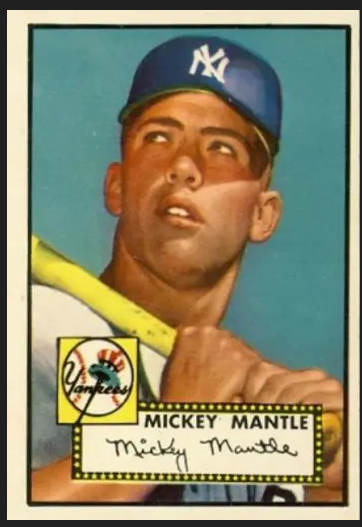
Kids collecting baseball cards. It has been going on for over 100 years. But the origin of the cards was not originally baseball.
Before the Civil War, photography was in it’s infancy. As photography grew in popularity, cabinet cards became fashionable. Cabinet cards were 4X6 and were to be displayed in a family’s cabinet.
Cabinet cards became popular around 1840. Coincidentally, baseball was gaining popularity too. By the end of the Civil War in 1865 baseball teams were popping up almost everywhere.
One of the earliest known cabinet cards contains an image of the 1865 Brooklyn Atlantics. As such, these are not pure baseball cards. Mostly these were used as business cards. No one company was producing them. But they are a window to how the card business would eventually start.
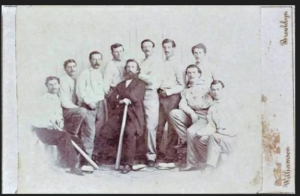
1865 Brooklyn Atlantics
The first true baseball cards were produced by a company called Peck and Snyder, a sporting goods company which produced them between 1868-70.
The front of the card had a photo of the respective team and a cartoon image representing the store in New York. The 1869 set featured the first professional team, the Cincinnati Red Stockings and came in two different sizes.
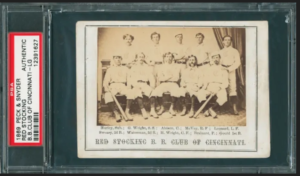
Technically, there were trade cards since they were given away instead of sold. It would be 20 more years before that would happen. It should also be noted that only 6 of these have ever been authenticated by PSA. At a recent auction, it was sold for 50,000 dollars.
By the late 1800’s, baseball was becoming the national pastime. It was then that Tobacco cards started being distributed inside cigarette packs. This was done also to stiffen the package so the cigarettes would not be crushed.
And since they were in packs of cigarettes, they were not being marketed for kids. That would not happen for another 25 years.
Tobacco cards varied in design and format. They were usually small, 25/8X1 1/2. The first set was issued by the Goodwin Tobacco company. They owned Gypsy Queen and Old Judge cigarette brands. It was the N167 set.
There were 12 cards in the set, all of them New York Giants. Not a stretch considering Goodwin was based in New York City. Between 1886-90, Goodwin was pumping out cards under it’s two brands. The N172 Old Judge is a massive set with over 500 players and 3000 variations known.
Those cards are fairly easy to find. The problem is finding one in good condition. Around the same time, Allen & Ginter, began issuing some of the most beautiful lithographic cards of the era. The first ones, N28, was one of the most popular issues of the 19th-century tobacco era.
Despite their age, over 140 years now, 4000 of these cards have been rated. But you can forget about a 10. None have made that mark.
A little side note for those who still collect, like me. You can get Allen & Ginter cards today with modern players on them. I have several Dodger cards from their set including Koufax, Snider, Kershaw and Seager.
Another popular tobacco set was Goodwin’s Champions N 162 set. It featured advanced commercial coloring of the day and was quite striking. Only 8 baseball players are in the set. One of the more popular is King Kelly. These cards can fetch as much as 500 dollars. Another popular card was that of Adrian “Cap” Anson.
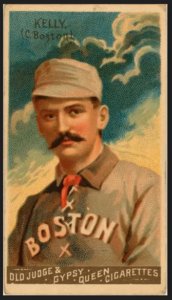
King Kelly
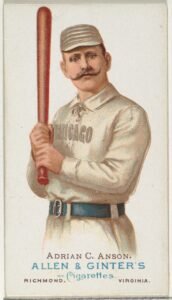
Cap Anson – Allen & Ginter
In 1890 the major tobacco companies joined forces and became The American Tobacco Company. So in this period, there were few cards produced since ATC was basically a monopoly until it was broken up in 1909. Given the fact that there was no competition, there was no need for incentive to sell cigarettes.
The Golden Age 1909-15
Tobacco companies were at it again after the breakup of ATC. The landmark set of the era is the fabled T-206 set issued from 1909-11. This set features a white border. They were issued in packs of the 15 brands still owned by American Tobacco.
Each back had a different advertisement for each company. The checklist consists of 524 T-206 cards. But there are over 6000 front and back variations, one reason this set is called the monster of baseball card sets.
The Honus Wagner from this set is instantly recognizable to even novice collectors. It is considered the Mona Lisa of baseball cards. Its rarity is due to it being pulled from production early in its run.
The reasons for this are still being debated. Either Wagner not wanting to be associated with smoking, or the lack of adequate compensation. Whatever the reason, it is estimated that between 50-75 Wagner’s still exist. Only a handful are in excellent or better condition. The last one up for auction sold for over 6 million in 2021.
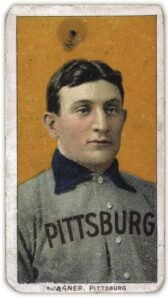
The cards also caused quite a commotion. When a new shipment of cigarettes would arrive, small boys would gather outside of the shops and pester the patrons into giving up their cards.
Despite the age of the set, over 180,000 have been graded. Of those, only 294 have received a 9 or a 10 grade. Commons can be found on Ebay for under 100 dollars.
Also popular were the cards issued by Cracker Jack, 1914-15. And the cards issued by American Caramel, 1909-11.
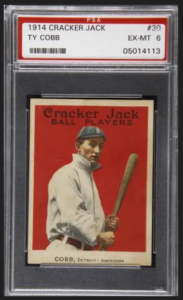
Also in this period there were cards issued by magazines, candy companies and bakeries. When WWI broke out, card production slowed down due to lack of materials.
After the roaring twenties were over, then came the crash, and owners were worried about attendance. It fell off 70 percent in 31-32. So the era of promotions began. Baseball on radio, night games. And it also helped when they started to sell packs of cards with gum in them for the kids.
It also helped to have the stars of the day right there promoting them. The first major set was made by Goudey. They made Big League chewing gum. The 1933 set featured 240 cards. All wonderfully colored portraits of the players. This would also be Goudey’s biggest set.
This is virtually a Hall of Famer set. Featuring Ruth, Gehrig, Foxx and Lajoie. Owing to his popularity at the time, the 33 Goudey set features four different Ruth cards.
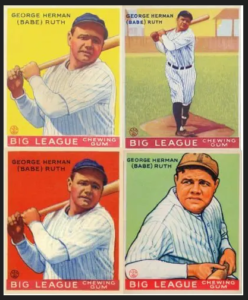
Perhaps the rarest of the group is the Lajoie. He was not included in the original set, but due to an outcry from fans, they made one in 1934. But the only way to get one was to write to the company and request it.
Subsequently, there are less than 100 that have been submitted for grading. So if you have one lying around, it could be worth a lot. A high graded 9 Lajoie sold for 144,000 in 2017.
Goudey would produce cards until 1941. The 34 set featured only 94 cards, one being the rookie card for Hank Greenberg. The 38 set contains Joe DiMaggio’s rookie card.
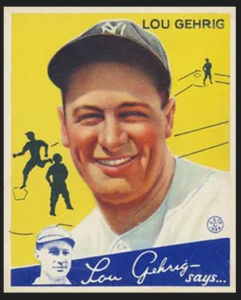
Lou Gehrig – Goudey 1934
Play Ball cards 39-41, were issued by the Gim Company of Philadelphia. Their 1939 Ted Williams is considered his true rookie card.
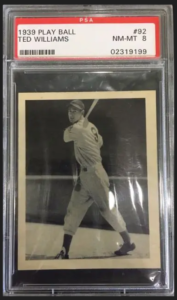
Ted Williams Rookie Card – 1939
WWII put an end to baseball card production. It would be 1948 before it started up again. Gum began selling cards in 1948 under the Bowman brand.
The Bowman’s were black and white photos, not particularly attractive. Bowman was competing with Leaf at the time. But leaf did not begin until 1949, although they say 48 on the cards.
The 48 Bowman’s was a small set, 48 cards, but Musial, Berra and Spahn all were featured cards. The Leaf set included the rookie cards of Robinson and Paige. The Leaf set featured color pictures for the first time post WWII.
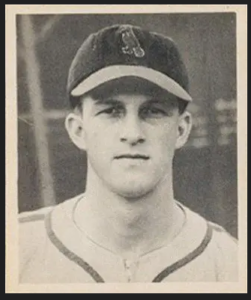
Stan Musial – Bowman 1948
The 51 Bowman is probably the most revered set from them. It features a Mays rookie. The 51 and 52 sets feature colored portraits. Bowman also features what would be considered Mantle’s rookie card, although that distinction is usually reserved for the 1952 Topps Mantle. Now one of the highest priced cards ever.
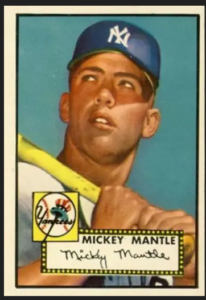
Mickey Mantle – Topps 1952
A company called Topps entered the scene in 1951. Their first foray into the business was their red and blue back cards in 1951. They were made to look like playing cards and featured a player’s photo and a baseball play on the front.
The Duke Snider card was a single. But they never really caught on, and the next year Topps would go in an entirely different direction, and the monopoly on cards was just beginning.
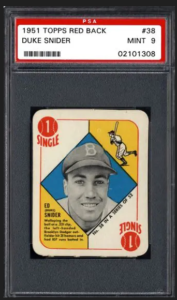
Duke Snider – Topps 1951 Red Back
Late in 1951, Topps employee, Sy Berger, designed the 1952 Topps card set on the kitchen table in his apartment in Brooklyn, using cardboard and scissors. Berger is now considered a legend in the collectors world. He worked for Topps for 50 years and is considered one of the most influential hobby Figures. He was even honored by the Hall of Fame in 1988, crediting him with the development of the baseball card.
On Topps of the World
The 52 Topps set broke the mold. These cards were bright, well designed and the fans loved them. The Mantle in this set has fetched record prices at baseball auctions. In August of 2022, one sold for 12.6 million dollars. In actuality it is a second year card since the 51 Bowman is considered his rookie card. Other rookies in the set, Eddie Mathews, Billy Martin, Hoyt Wilhelm, Gil McDougald, and Joe Nuxhall.
The 52 Bowman cards tried to keep up. They were also painted portraits of the players with a white border. Unlike the Topps which had the players autograph in a rectangular box and the teams logo in the upper left corner of the box, Bowman had the players autograph across his portrait. No team logo.
These cards were still a little larger than the cards made today are. It would be 1957 before the 2 1/2X 3 1/2 size would become standard.
The autograph was taken from the contract the player signed with Topps. The back featured the prior seasons stats and lifetime stats. It also featured a short bio of the players and his personal statistics such as height, weight and which way he hit and threw.
The set was also released in six series with the stars usually being in the final series. This created what would become a shortage of cards in series six being sold since it usually was not released until September, and would only be in stores a short time.
Berger confessed that unsold cards were loaded into onto a garbage scow and dumped into the Atlantic ocean. Maybe 300 to 500 cases.
Over the next several years, Topps and Bowman battled it out, and by that I mean in court. The haggle was over signing players to exclusive rights. Legal costs usually were over 100,000 a year. Up until 1954, no card company had ever sold over 1,000,000 dollars worth of cards.
Topps finally bought out Bowman in 1956 thus establishing their monopoly on baseball cards which has lasted until now.
The 1955 Bowman set was their last full set. And it was unique in design since the players were placed in what looked like a TV set.
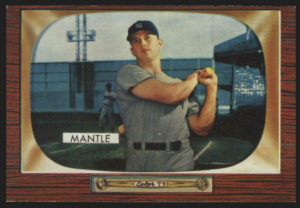
Mickey Mantle – Bowman
Oh there were still other company’s making cards, but not in the volume Topps was. O’Pee Chee, Leaf, Fleer, all made cards. Food company’s would offer local teams cards.
But Topps was the big dog. Using the players actual photos in different formats became the norm in the mid-50’s. The 54 Topps sets also used a player posing either hitting or fielding next to the photo of the player. In a pitchers case it was throwing. 55-56 the cards were horizontal instead of vertical with the same two images of the player.
In 1957 they changed the size and once again it was a photo of the player on the field with his name, position and team in block letters below his photo. They had a white border. One of the more famous error cards is in this set. The Hank Aaron card negative was reversed and it shows him hitting left-handed.
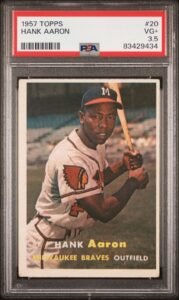
Hank Aaron – 1957 Topps – Batting Left Handed
The 58 card was very plain with a players photo on a different colored back ground. Name and team below the photo with the teams logo on the front.
Since the Dodgers and Giants had moved west, the logo on their hats was airbrushed on and not entirely accurate. Also some players who had been traded were shown capless. A trend that continued for many years until Topps started making traded sets that were released in the middle of the season.
The 59 set is still my favorite, since LA won the Championship that season and I loved the style. Different colored borders around the players photo which was in a circle. Logo name and position on the front. Dark and lighter colored backs with his entire career stats for each season. Series 7 had lighter backs with darker ink used. That is where you find Wally Moon and a couple of other Dodgers. Duke Snider was #20 in series one.
In the 60’s, Fleer got the rights to make cards of Hall of Famers. They would make two sets, 60-61. They actually got away with making a card for a player who was not yet a Hall of Famer, Ted Williams, in 1960. 60 was Williams last season.
In 1975, Fleer asked Topps for permission to print stickers and other non-card items of active players. Topps refused. Fleer then sued them to break the monopoly. After years of litigation, in 1981, Fleer won the suit and the MLBPA and Topps were ordered to issue licenses to other company’s. Fleer and Donruss began making sets in 1981.
Topps and Donruss also had sets issued for Canadian fans. Some were made under the Leaf brand. O-Pee-Chee and Topps also.
Topps sued again over issuing cards with gum. They won that suit and Fleer continued issuing cards without gum. Donruss did the same. Fleer would issue stickers with their cards and Donruss came up with the Diamond king puzzles.
Over the years, other companies would also produce cards like Pacific trading company. Their cards were pretty plain with usually just player photos and bios and stats on the back. Some were in color and others in black and white.
Bell Brand potato chips made Dodger cards for a couple of years. Ted Williams had his own brand of cards. Cards are even sold digitally now. I am not into that.
Baseball will be ending it’s agreement with Topps after the 2025 season. The new agreement will be with a company being formed by Fanatics, a sports merchandise company. The new company has yet to be named. Topps will continue to make baseball cards through the 25 season.
Topps alters the design of each season in some minute way. Upper Deck is the other main producer of baseball cards. These cards are usually high end, high gloss photos and also feature uniform swatches and other pieces of memorabilia.
The way cards are collected now has also changed. Used to be that most transactions were done at card shows and small shops. Most collectors now use the internet. This also changed the way the cards have been marketed.
Cards are so popular that the MLB. Network has a show dedicated to collecting called Carded. There have been some very interesting shows about collecting there.
Since getting the originals can be extremely expensive. I have usually gotten some of the older cards through the purchase of the archives cards. These are the size of the cards made today and are easily found on Ebay.
I also expanded my collection to include many Negro League stars who I had never seen cards of before. One of my favorites is a card of Josh Gibson. I also have a couple of cards made of porcelain.
I know some of you still collect like I do. I hope this short history of cards has been informative.
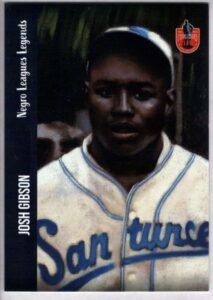













It is being reported that Kike Hernandez is expected to sign a contract by Monday. Angels, Brewers and Dodgers listed as the likeliest destinations. Duke and Sandy 59 topps
I started collecting in ‘56. Had a shoebox full of my favorites by the time I joined the Marines in ‘66. (Ten years doesn’t sound like very long now. Sure was then.) That box disappeared when I was in ‘nam. I do know where my crate of LP’s went. My ex sold them at a garage sale while I was out town. Lovely woman my ex. She really seemed to care. Can’t help but wonder what the content of those two boxes would be worth now.
Way to go Bear. One heck of an article. I enjoyed it very much and learned alot. Keep up the good work.
Going to miss today’s game, playing music with some friends in our community room. I can watch it later.
The new uni’s pants are the focus of many of the players dislike of the new uniforms. Apparently, the material is thin enough to see through. I looked closely at some photos of the pants, and I concur. You can see the difference in the players underwear and their legs.
Joe Nuxhall! Wasn’t he 16 when he first pitched in the majors?
When I was about 11 years old, my best pal and I merged our baseball card collection. I had quantity–a couple thousand cars–and in the early 1960s we had little appreciation for the quality my friend brought to our partnership.
My cards were all from the 1960s, collected in those Topps packs with a stick of gum. My friend had been give a shoebox full of older cards by a cousin. Real beauties from the “50s and ’40s, mostly. Not in great condition, but not that bad either. Nobody we knew kept them protected in plastic cases. We made up games with them, and they got thrashed.
We kept the cards at my house and gradually lost interest. The were stuffed in a large brown shopping bag in a closet. And one day when I was about 17 my sister decided to toss the bag in the trash.
I still haven’t forgiven her. Never will.
Great stuff, Bear. Even if it brings up painful memories.
Have to get ready for the jam, will check in later.
Fantastic article Bear! I had a complete set of 1959 and 1960 Topps along with a complete set of 1961 Fleer Hall of Fame. My Dad had built a beautiful wooden box to keep my collection in. It had four slots which each held an entire year of cards. I sold them about five years ago on a online auction. It was time for someone else to enjoy them. I had no family that was interested in collecting. I still have the box though.
A friend I grew up with had an 1959 unopened box (counter display) with unopened packs. It sold online for $43,000! I was shocked at that price. Turns out his brother had a case of those boxes all unopened.
Those cards and the collecting created lots of good memories.
Thanks again Bear.
Hey, a Willie Calhoun sighting. I remember when he first signed with the Dodgers Timmons said he would never be able to run fast enough to play baseball. Not with those thick legs. I mentioned Kirby Puckett and Tony Gwynn. He never recanted of course.
You know the stat FIP? Fielding Independent Pitching. I think they should have another stat for umpire bad calls. UIH. Umpire Independent Hitting. Every missed call that results in out the at bat won’t count.
Dodgers are not listed as one of the four teams in on Kike Hernandez. But the Giants are. Hopefully he signs with the Angels instead.
Jam today was a lot of fun; I watched the 9th inning of the game. My one concern, 36 strikeouts in three games. Unacceptable.
Cody Bellinger reportedly resigns with the Cubs. Reported as a 3yr/$80M deal with opt outs after 1st and 2nd years. Sounds like a good deal for both parties. Cubs should try and get Snell and Chapman on similar deals. They would instantly be the favorites in the NL Central.
Did Mark start his Dodger Talk website yet?
Rosenthal: Bellinger’s 2023 .307 batting average, 26 home runs and .881 OPS were built on an average exit velocity that exceeded only one out of five major leaguers. Teams were not convinced that Bellinger’s bounceback was sustainable, that he had fully overcome the struggles of his injury-marred 2021 and ‘22 seasons.
Former Dodger, Matt Kemp is going to be hired by the team in an advisory role. Second former player this year, Nelson Cruz was the first.
Muncy and Outman both homer off of LH pitchers. Outman also had a single against a lefty.
Shohei Ohtani will make his LAD spring training debut on Tuesday. Per Freddie, that is the day that we will learn who bats 2 and 3.